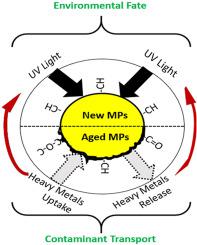Environmental Pollution ( IF 7.6 ) Pub Date : 2022-06-15 , DOI: 10.1016/j.envpol.2022.119628 Amali Herath 1 , Maryam Salehi 1

|
The weathering and contaminant transport behavior of both primary (PMPs) and secondary microplastics (SMPs) are interrelated to their original physiochemical features and variations within the environment. This study examines the influence of PMPs' intrinsic characteristics (polymer structure and crystallinity) and SMPs' extrinsic features (surface oxidation and external sediments attachment) on the photodegradation kinetics, and subsequently Pb(II) and Zn(II) uptake from stormwater. For this purpose, high density polyethylene (HDPE) and low density polyethylene (LDPE) with different degrees of crystallinities were produced as PMPs, and their photodegradation behaviors were compared with original polymers. Furthermore, the SMPs generated by abrasion and surface oxidation of PMPs and the virgin PMPs underwent accelerated photodegradation, and the changes of their crystallinity, surface chemistry, and morphology were examined. Scanning electron microscopy (SEM) imaging and X-ray photoelectron (XPS) studies revealed the formation of cracks and different oxidized functionalities on MPs surface due to UV photodegradation. The vinyl and carbonyl indices calculated using Attenuated Total Reflectance Fourier Transform Infrared (ATR-FTIR) spectroscopy demonstrated an elevated photodegradation rate for SMPs compared to the PMPs. Moreover, the Differential Scanning Colorimetry (DSC) demonstrated an increasing percentage of crystallinity in all MPs due to the photodegradation. The percent crystallinity of HDPE pellets increased after photodegradation from 49.8 to 62.6 and it increased from 17.2 to 38.9 for LDPE pellets respectively. The greater level of increase in crystallinity for LDPE in comparison to HDPE upon photodegradation was referred to as LDPE's greater amorphous content and branched structure. A greater level of metal uptake was obtained for photodegraded LDPE pellets as 2526 μg/m2 for Pb(II) and 2028 μg/m2 for Zn(II) respectively.
中文翻译:

研究微塑料的内在和外在特性对其风化行为和暴雨径流中重金属迁移的综合影响
初级 (PMP) 和次级微塑料 (SMP) 的风化和污染物迁移行为与其原始的物理化学特征和环境中的变化相互关联。本研究考察了 PMP 的内在特征(聚合物结构和结晶度)和 SMP 的外在特征(表面氧化和外部沉积物附着)对光降解动力学以及随后从雨水中吸收 Pb(II) 和 Zn(II) 的影响。为此,制备了具有不同结晶度的高密度聚乙烯(HDPE)和低密度聚乙烯(LDPE)作为PMP,并将它们的光降解行为与原始聚合物进行了比较。此外,由 PMP 和原始 PMP 的磨损和表面氧化产生的 SMP 经历了加速的光降解,并检查了它们的结晶度、表面化学和形态的变化。扫描电子显微镜 (SEM) 成像和 X 射线光电子 (XPS) 研究表明,由于紫外光降解,MPs 表面会形成裂纹和不同的氧化功能。使用衰减全反射傅里叶变换红外 (ATR-FTIR) 光谱计算的乙烯基和羰基指数表明,与 PMP 相比,SMP 的光降解率提高。此外,差示扫描比色法 (DSC) 表明,由于光降解,所有 MP 中的结晶度百分比增加。光降解后 HDPE 颗粒的结晶度百分比从 49.8 增加到 62.6,而 LDPE 颗粒的结晶度从 17.2 增加到 38.9。与 HDPE 相比,在光降解时 LDPE 结晶度的更大程度增加被称为 LDPE 更大的无定形含量和支化结构。光降解 LDPE 颗粒的金属吸收率更高,为 2526 μg/mPb(II) 和 Zn(II) 分别为2和 2028 μg/m 2。











































 京公网安备 11010802027423号
京公网安备 11010802027423号